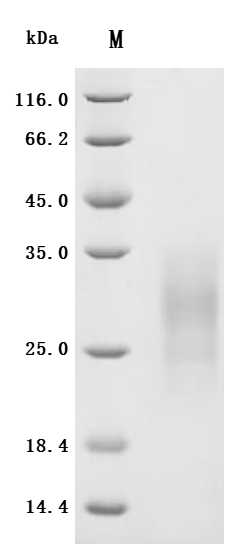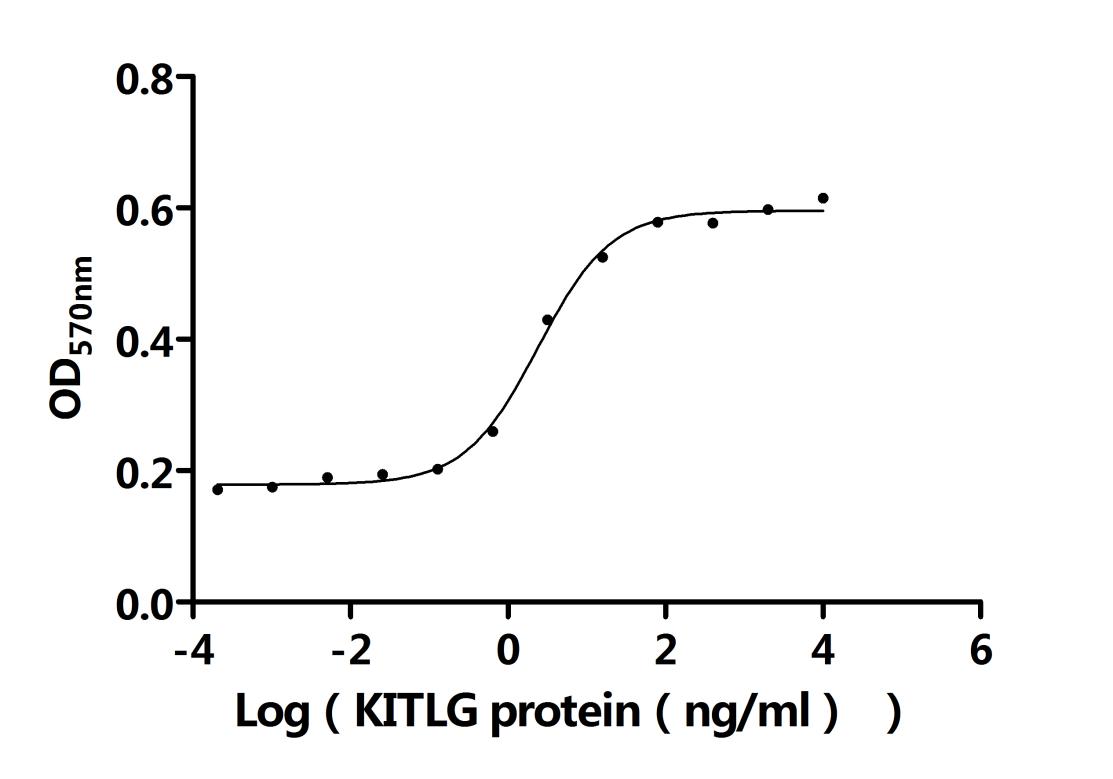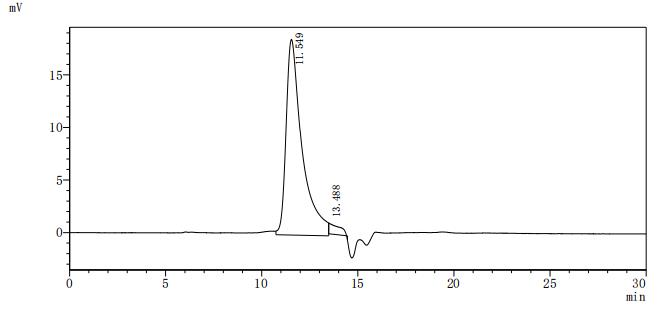The recombinant human KITLG protein is an active protein expressed in mammalian cells, covering amino acids 26 to 189 of the native human KITLG sequence. It features a C-terminal 10xHis tag, facilitating purification and detection. Supplied as a lyophilized powder, the recombinant KITLG protein demonstrates high purity, exceeding 95% as verified by both SDS-PAGE and SEC-HPLC analyses. Functionally, it retains strong biological activity, with an ED50 ranging from 1.813 to 3.203 ng/mL based on its capacity to stimulate proliferation in MO7e cells in a dose-dependent manner.
Human KITLG, also known as stem cell factor (SCF) or mast cell growth factor (MGF), is essential for the proper development, migration, and function of various cells, including hematopoietic cells and melanocytes. The KITLG-c-KIT interaction is pivotal in multiple biological processes, ranging from hematopoiesis to pigmentation [1].
KITLG is produced in both transmembrane and soluble forms, which are encoded by different isoforms of the gene. The exon 6-containing transcript leads to a soluble variant of KITLG, while the variant lacking exon 6 results in a membrane-bound protein. These two isoforms have distinct biological roles, influencing cell survival, proliferation, and differentiation in hematopoietic and other cell types [2]. KITLG is also involved in tumorigenesis. In hematological malignancies, KITLG can promote survival and proliferation of malignant cells by activating signaling pathways downstream of the c-KIT receptor [3].
KITLG is crucial in several developmental processes, particularly during melanocyte migration and differentiation. Studies have shown that the interaction between KITLG and c-KIT is important for melanocyte migration during embryonic development. Dysfunction in this pathway is related to skin pigmentation disorders [4][5]. Additionally, genetic variations in the KITLG gene have been associated with differences in pigmentation among human populations, highlighting its evolutionary significance [1].
Moreover, KITLG is linked to various health conditions, including infertility in males, where its expression levels in seminal plasma correlate with sperm count and fertility potential [6][7]. Furthermore, polymorphisms in the KITLG gene have been implicated in bronchopulmonary dysplasia and other diseases, suggesting that variations in KITLG expression may influence disease susceptibility through effects on immune and inflammatory pathways [8].
References:
[1] C. Guenther, B. Tasic, L. Luo, M. Bedell, & D. Kingsley. A molecular basis for classic blond hair color in europeans. Nature Genetics, vol. 46, no. 7, p. 748-752, 2014. https://doi.org/10.1038/ng.2991
[2] Y. Zhou, S. Huangfu, et al. Dazap1 facilitates the alternative splicing of kitlg to promote multiple myeloma cell proliferation via erk signaling pathway. Aging, vol. 14, no. 19, p. 7972-7985, 2022. https://doi.org/10.18632/aging.204326
[3] X. Liu, R. Lu, Y. Xia, & J. Sun. Global analysis of the eukaryotic pathways and networks regulated by salmonella typhimurium in mouse intestinal infection in vivo. BMC Genomics, vol. 11, no. 1, 2010. https://doi.org/10.1186/1471-2164-11-722
[4] M. Amyere, T. Vogt, et al. Kitlg mutations cause familial progressive hyper- and hypopigmentation. Journal of Investigative Dermatology, vol. 131, no. 6, p. 1234-1239, 2011. https://doi.org/10.1038/jid.2011.29
[5] S. Williamson, M. Hubisz, A. Clark, B. Payseur, C. Bustamante, & R. Nielsen. Localizing recent adaptive evolution in the human genome. Plos Genetics, vol. 3, no. 6, p. e90, 2007. https://doi.org/10.1371/journal.pgen.0030090
[6] J. Galán, M. Felici, et al. Association of genetic markers within the kit and kitlg genes with human male infertility. Human Reproduction, vol. 21, no. 12, p. 3185-3192, 2006. https://doi.org/10.1093/humrep/del313
[7] F. Corredor, L. Sanglard, J. Ross, A. Keating, R. Leach, & N. Serão. Phenotypic and genomic relationships between vulva score categories and reproductive performance in first-parity sows. Journal of Animal Science and Biotechnology, vol. 12, no. 1, 2021. https://doi.org/10.1186/s40104-020-00527-1
[8] J. Huusko, M. Mahlman, et al. Polymorphisms of the gene encoding kit ligand are associated with bronchopulmonary dysplasia. Pediatric Pulmonology, vol. 50, no. 3, p. 260-270, 2014. https://doi.org/10.1002/ppul.23018









